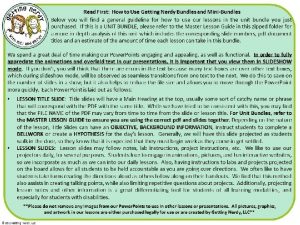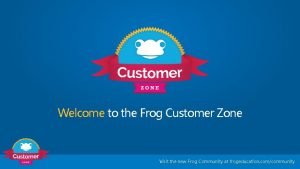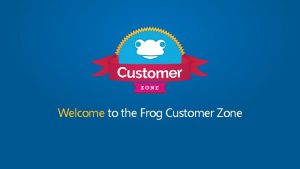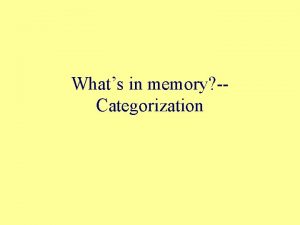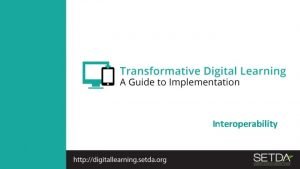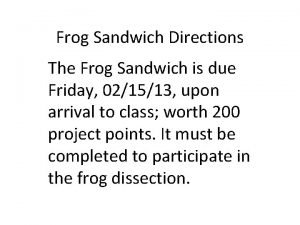Welcome to Frog Training Exemplar Sites The Exemplar












- Slides: 12

Welcome to Frog Training Exemplar Sites

The Exemplar Site Campaign Mission Statement: To equip teachers with the skills and knowledge to create teaching & learning sites of quality. Objectives: • Saving teachers time • Improving learning outcomes • Increasing student engagement

The Exemplar Site Campaign Question: How do I know if my site is up to standard? Answer: By using the rubrics for exemplar sites guide.

What is a Rubric? Rubric (noun) “A document that articulates the expectations for an assignment by listing the criteria and describing levels of quality”

What are Rubrics used for? Teachers can use the rubrics as a guide to ensure their site meets the required standards. Create a Site Check site against rubrics criteria Send to MOE repository

What do the Rubrics measure? 1. Instructional Design & Delivery 2. Online Organization & Design 3. Learner Support and Resources 4. Learner Participation 5. Assessment & Evaluation of Student Learning

1. Instructional Design & Delivery is the art and science of creating an instructional environment and materials that will allow the learner to accomplish specific tasks. Category Baseline Learning Objectives ● Effective Exemplary Learning objectives are incomplete. ● Learning objectives are stated vaguely. ● Learning objectives are stated clearly. ● Learning activities are absent or unclear. ● Learning activities are implied. ● Learning activities are clearly integrated with the objectives. Inclusion of Learning Styles ● Limited visual, textual, ● kinaesthetic and/or auditory activities to enhance student learning. Adequate visual, kinaesthetic and/or auditory activities to enhance student learning. ● Multiple visual, kinaesthetic and/or auditory activities to enhance student learning. Critical Thinking and Problem Solving Activities ● Limited activities to help students develop critical thinking and/ or problemsolving skills. ● Adequate activities to help students develop critical thinking and/or problemsolving skills. ● Multiple activities to help students develop critical thinking and problem-solving skills.

2. Online Organization & Design Online organisation and design concerns how the information in the site is presented. Category Organization Content Aesthetic Design Baseline Effective Exemplary ● Much of the Site is under construction. ● Site is organized and navigable. ● Site is well-organized and easy to navigate. ● Components and structure of the Site are incomplete. ● Several components and structure of the Site are complete. ● All components and structure of the Site are complete. ● Content is not chunked into manageable segments. ● Content is partially chunked into manageable segments. ● Content is not presented in sequence. ● Content is presented in a logical sequence. ● Aesthetic design presents and communicates information clearly throughout the Site. ● Aesthetic design does not communicate information clearly. ● Content is not presented in a logical sequence. ● Presentation of information in some parts of the Site can still be improved.

3. Learner Support & Resources Learner support and resources concerns how students are supported during their learning. Category Baseline Effective Exemplary Online Learning Resources ● Limited information for online learner support in terms of online resources and references. ● Adequate information for online learner support in terms of online resources and references. ● Learning Tools ● Limited help and support for web tools used within the Site. ● Adequate help and support ● for web tools used within the Site. Extensive help and support for web tools used within the Site. Instructions ● Minimal or vague instructions are provided. ● Instructions are not provided for some learning activities. ● Clear instructions are provided for all learning activities. ● A lot of clarification is needed from the teachers. ● Some clarifications are needed from the teachers. ● No clarification is needed from the teachers. Extensive information in terms of online resources and references.

4. Learner Participation Learning participation dictates how the student interacts with the site. Category Opportunity for Participation Baseline ● Effective Limited opportunity for ● students to participate within the Site. Adequate opportunities for students to participate within the Site. Example, Site is used mainly as a content repository. Interaction and Communication ● Limited opportunity for student-to-student and student-to-teacher interaction. Exemplary ● Multiple opportunities for students to participate within the Site. Example, Students are able to share ideas or comments using Frog Widgets. ● Adequate opportunities for student-to-student and student-to-teacher interaction. ● Multiple opportunities for student-to-student and student-to-teacher interaction.

5. Assessment & Evaluation of Student Learning contains two elements. The first concerns the alignment of the objectives with the assignment activity. The second criteria is related to feedback. Category Baseline Effective Exemplary Learning Objectives and Assessment Alignment ● Learning objectives, instructional and assessment activities are not aligned. ● Learning objectives, instructional and assessment activities are adequately aligned. ● Student Performance Feedback ● Limited opportunities for students to receive feedback about their own performance. ● Adequate opportunities for ● students to receive feedback about their own performance. Learning objectives, instructional and assessment activities are closely aligned. Multiple opportunities for students to receive feedback about their own performance.

Training Agenda Topic Trainer Activity Trainers and support staff introduced. Introduce agenda and purpose of session. Session Start Introduction Housekeeping Ask all participants if they have brought with them their MSL resources. Introduction to Sites Rubrics for Exemplar Sites Content • • • Introduce sites. Compare the • traditional method of teaching to teaching with a Site. • Explain the 5 criteria of what makes an exemplar site. Ask participants to create a Hands on: Create a Site site for use in one of their lessons. Computer. Yes ID. Lesson Plan. T&L Site. What is a Site? Paper based lesson vs Site based lesson demonstration. Exemplar Site overview (use Aizams site as example) • Instructional Design & Delivery. • Online Organization & Design. • Learner Support and Resources. • Learner Participation. • Assessment & Evaluation of Student Learning. All participants to create a T&L site for use in a lesson. Site must be uploaded to MOE Rep at end of session. Q&A Session Answer any questions that participants may have. All participants to take part in Q&A session. Feedback Ask participants to complete online form. All participants to complete online form. Session End Time TBC TBC
 Frog scienstructable key and functions answers
Frog scienstructable key and functions answers Pig scienstructable key and functions
Pig scienstructable key and functions Levenshulme high school frog
Levenshulme high school frog Frog penistone
Frog penistone Exemplar theory
Exemplar theory Exemplar model
Exemplar model How to write an exemplar essay
How to write an exemplar essay A level computer science exemplar candidate work
A level computer science exemplar candidate work 91035 exemplar
91035 exemplar Contents page epq
Contents page epq Rapid exemplar
Rapid exemplar Gde blueprints
Gde blueprints Merchant of venice exemplar essay
Merchant of venice exemplar essay

